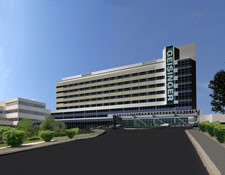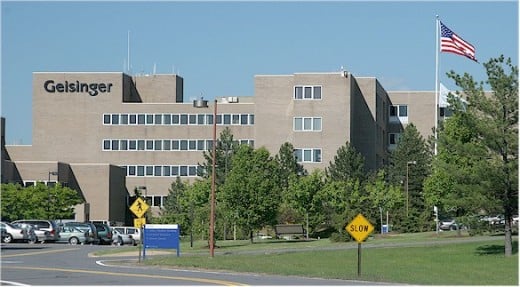Geisinger Health System - Why Obama Named it in His Healthcare Reform Speech
Who is Geisinger Health System?
Geisinger was founded in 1915 by Abigail Geisinger, widow of George Geisinger. She used her sizable fortune to build a hospital intended to be a regional medical center modeled on the Mayo Clinic.
As such it was a small rural hospital of seventy (70) beds.
Since that time Geisinger has grown to become Geisinger Health System (GHS) and now encompasses a forty-three (43) county area with a total of sixty-seven (67) sites.
These sites include single physician offices, in-store clinics, and a large campus in Danville, Pennsylvania. Geisinger is not only a provider, it is also an insurer with approximately 30% of it's patients on it's plan. The other 70% are served by other plans. This represents a total of seven hundred eighty-three thousand (783,000) patients currently serviced by Geisinger. The Danville, Pennsylvania hospital serves a community of roughly two million.


How they Pay Doctors
Doctors working for Geisinger initially have to get used to it's pay schedule. They are essentially employees of the system, not free-agents. As an employee doctors initially make 80% of the national pay rates for their profession. This may not sound all that good but GHS CEO Dr. Glenn Steele has a plan...and a good one at that.
General practitioners in the system, like most GPs, initially make less money than their specialist counter-parts. But this is only temporary. To help narrow the pay gap Geisinger specialist fields help subsidize the GPs. The trick is to not to take too much from the specialists such as orthopedists and cardiologists.
Dr. Glenn Steele, CEO of GHS stated that: "I couldn't recruit if I didn't do that. We don't want our family doctors setting up their own radiology clinics."
In saying this Dr. Steele highlights a common practice among general practitioners & family doctors. Many routinely set up clinics and specialized services (such as XRay or hematology labs) to help supplement their earnings.
Even though GHS doctors are salaried employees, their pay is not fixed in advance. Salaries are geared to stay within eighty (80%) percent of the national average, but they are also set up to close the gap on the twenty (20%) percent based on performance goals; a bonus for lowering the return rate of patients.
If, for example, the coronary care group can keep it's re-admission rates below a set level, doctors are compensated with bonuses. These bonuses come out of the savings Geisinger Health System realizes with reduced complication rates.
The same holds true for a pediatric orthopedic team. These teams must treat kids for spinal problems without being in too much of a hurry to operate on children who don't need it while not being too slow for those who do. Again the ultimate goal is to reduce the rate of readmission. interestingly, lowering readmission also means better patient care.
Dr. Steele's example: "We keep cash compensation flexible with incentives. That takes away some of the insane piecework."
The Geisinger Method
Former Treatment Practices
Before the transformation GHS used to use the a la carte method of
billing, where each separate specialist billed for his/her time. This approach also extended to post-op where patient care
fell to whoever happened to be on duty at the time.
Beside the billing nightmare, this method of treatment posed other problems. If a patient had a problem the nursing staff had to ask "who's patient is this" before asking "what is the problem." This stemmed from the fact that different doctors used differing methods of treatment.
These differences could even extend to how a patient might be wired to a monitor.
This is how most hospitals, specialists, and health-professional operate across the United States today.
GHS Solution
Starting in 2004, Dr. Steele decided to fix these problems by switching GHS over to a prix fixe (French for fixed price), episode-care model for surgery.
Beginning with heart bypass surgery, a tight knit team of caregivers are responsible for every stage of the bypass procedure. This includes the patient's post-op treatment and recovery. GHS submits a single bill to the patient for all work performed. Gone is a separate bill from the anesthesiologist, surgeon, etc.
GHS even includes a 30 day pre-op and 90 day post-op warranty. The warranty guarantees that if a patient checks back into the system with any complications during the warranty period, those expenses are picked up 100% by GHS.
Of this method Dr. Steele states: "We'll do it right, or we won't send a bill."
Heart Bypass Surgery was the first model to change.This first step toward this goal was to codify twenty (20) steps performed in a bypass operation and standardize them. This standardization was geared toward reducing any variability in care. The steps went so far as to determine precisely what drugs and dosages doctors would use for every patient. As the checklist was fine tuned it expanded to forty (40) steps.
Initially doctors objected calling the process "cookbook medicine." But when patient readmission rates began to fall and the savings became apparent (along with bonuses) GHS doctors overwhelmingly signed on to the new methods.
After a three hundred twenty (320) bypasses had been performed under the new rules it was noted that patients had far fewer complications and went home sooner. This reduced complication rate cut patient cost by about $2,000 each. The savings were promptly passed on to the doctors as bonuses.
Since then GHS doctors have begun creating similar checklists for hip-replacement, bariatric & cataract surgeries.
ProvenCare
GHS calls this practice ProvenCare and this practice hinges on three principals:
- a strict reliance on evidence-based standards in medicine
- a financial mechanism to pay for certain procedures
- patient engagement/activation
What Nursing Staff Say about GHS
Danville, PA
Janet Tomcavage, an R.N. at GHS, said that changing the health care system is contingent upon bringing the quality of care up while paring the expenses down.
“It’s going to require a whole new attitude,” she said. “This has driven some good outcomes,” she continued “Mortality has dropped. Readmissions have dropped. And the hospital has not lost money.”
Tomcavage went on to say: "A lot of hospitals will tell you they literally throw people over the wall, ‘You need to be out of here by 11 o’clock,’ that sort of thing, [but] If the patient can’t manage the tubes or the pills they’re going to be right back in the hospital. The sensible thing to do is make sure they can cope first."
Tomcavage summarized with: "More service upstream, and we can keep people well, at home.”
She also stressed the need for different specialists to talk. As an example she cited a patient with kidney problems. More fluids are good for the kidneys; less are better for the heart. Specialists tend to think only of "their organ" so its important for the cardiologist and renal specialist to talk to each other about the same patient. This communication also reduces readmission rates.
Wyoming Valley, PA
Victoria
Keeler, R.N. states of a special position called Nurse Navigator: "Being diagnosed and coping with a breast disease can be confusing,
stressful and incredibly overwhelming. Breast care navigators can help patients sort
through the many questions and uncertainties that arise throughout
their course of treatment."
Nurse Navigators provide comfort and support regarding both malignant and benign breast diseases. They are also charged with helping the patient understand various treatment options.
Nurse Keeler went on to say: "Navigators do not offer opinions or advice on treatments; they support
physicians and their decisions. A navigator is an extra resource that
can provide additional information to patients."
Geisinger Financials
As of 2008, Geisinger Health Systems operating revenue was nine hundred forty-three ($943,000,000) million dollars.
Medicare contributed roughly thirty-three (32.7%) percent of these funds.
Medical Assistance contributed to approximately seven (6.6%) percent of the hosptial net patient revenue. Roughly one point five (1.5%) percent of inpatient care was uncompensated care.
Reason for this Hub
After listening to President Obama's speech to congress I became curious as to who Geisinger Health System was. This hub is the result.
With all of the Republican nay-saying regarding a health care overhaul, especially in light of the fact that they keep referring to the attempts at reform as "socialized medicine", I thought i particularly important to concentrate on the fact that doctors are paid and earn bonuses for performance. Also, GHS is profitable.
This is not socialized medicine by any stretch of the imagination.
Disclaimer
The author of this article is not compensated in any way, monetarily, by discount, or freebies by Geisinger Health System or any of it's subsidiaries.
Geisinger Health System
- Geisinger Health System | Home
Main portal to the Geisinger Health System.










